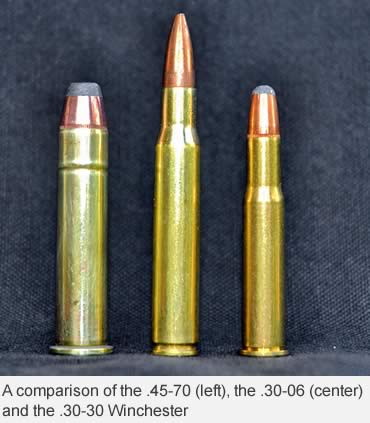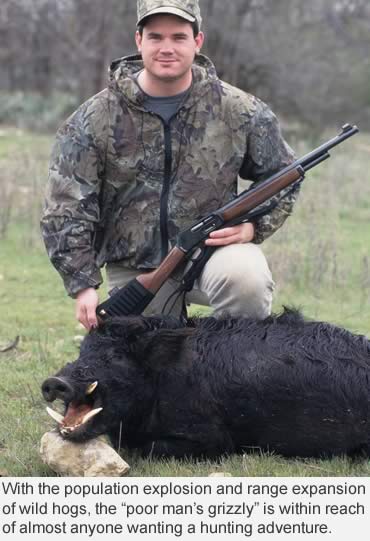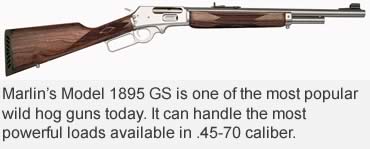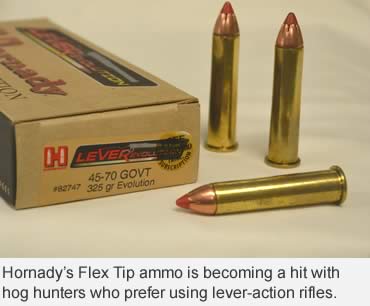By J. Wayne Fears
The stout .45-70 cartridge is bad medicine for big pigs.
Photo: Winchester recently reintroduced the modern .45-70 Model 1886. It’s a dandy.
Few calibers available to the wild hog hunter have a more colorful history than the .45-70 Government. Popular among settlers, buffalo hunters, cowboys, lawmen and others, the cartridge was with Gen. George A. Custer at the battle of the Little Big Horn.
The .45-70 is experiencing a revival because of the excellent factory ammo that is available. Modern .45-70 loads are a good choice for large boars, so much so that it is rapidly becoming the caliber of choice of many hog hunters.
The .original .45-70 cartridge consisted of a .45-caliber bullet over 70 grains of blackpowder. It was adopted as the official U.S. military cartridge for use in the Springfield Model 1873 rifle, known to collectors as the Trapdoor Springfield.
 In 1892, the U.S. military dropped the .45-70 in favor of the .30-40 Krag. This did not mean an end to the .45-70, however. It was later used in the Spanish-American War and by state militias until well into the 20th century.
In 1892, the U.S. military dropped the .45-70 in favor of the .30-40 Krag. This did not mean an end to the .45-70, however. It was later used in the Spanish-American War and by state militias until well into the 20th century.
Interest in the .45-70 declined so much in the 1930s that American gun makers stopped chambering it. Ammunition continued to be available, though.
The .45-70 was rediscovered in the late 1960s. Sportsmen found it ideal for deep- woods hunting and easy to reload. There was also a renewed interest in old guns and calibers among history buffs.
Hunting with the .45-70
My first exposure to the .45-70 came when I became a guide in an elk camp. All of the local guides carried Marlin Model 1895 rifles in .45-70 and also handloaded cartridges to get muzzle velocities up to 2,000 feet per second.
A rancher I met during this period took a trophy class bull every year with his Marlin 1895 in .45-70. He usually got his bull in dark timber at fairly close range — less than 125 yards.
 The following year, I had to cull a large number of deer on a property I managed for a research project. Tom Gresham, now host of Gun Talk Radio, was working with me on this project.
The following year, I had to cull a large number of deer on a property I managed for a research project. Tom Gresham, now host of Gun Talk Radio, was working with me on this project.
On the first day, he broke out a Marlin Model 1895 rifle in .45-70. We were hunting in thick swamp country and Tom wanted to test the performance of this caliber on whitetails.
All of the biologists kidded Tom about using the cannon for deer hunting. After a couple of days of watching the gun perform, I asked him to give me a turn with the rifle.
On hunts in Alaska, I’ve noticed that many outfitters keep a .45-70 rifle handy as insurance in the event a grizzly bear comes visiting.
Ron Bullock, a good friend, lived and worked in the heart of Alaskan brown bear country for many years. He told me a Marlin 1895 in .45-70 is much better bear protection than a .44 Magnum revolver. He carried a Marlin 1985 SS for protection from renegade bears.
Match the Ammo With the Rifle
One drawback of the .45-70 is that factory loads are kept relatively mild to shoot in old guns with weaker actions. These include the Springfield 1873 Trapdoor, Whitney Rolling-Block, Remington No. 1 Rolling Block, Sharps 1874 Side Hammer, Ballard single shot, and the Marlin 1881 repeater.
The strongest actions are found in the Browning 1885, Browning B-78, Siamese Mauser, Ruger No. 1, Marlin Model 1895, Thompson/Center G2 Contender, T/C Encore and Winchester 1896 short rifle.
 Factory .45-70 loads from Remington, Federal and Winchester have a muzzle velocity around 1,800 fps. These cartridges are deadly on hogs out to 150 yards. Trajectory with a 100-yard zero is minus 7 inches at 140 yards and 12 to 30 inches low at 200 yards, depending upon load.
Factory .45-70 loads from Remington, Federal and Winchester have a muzzle velocity around 1,800 fps. These cartridges are deadly on hogs out to 150 yards. Trajectory with a 100-yard zero is minus 7 inches at 140 yards and 12 to 30 inches low at 200 yards, depending upon load.
Other loads made for strong actions have been introduced in recent years.
Garrett Cartridges has a family of hunting rounds with Super Hard Cast Hammerhead lead bullets. These loads will shoot through the largest boars, from head to tail, out to 200 yards.
In addition to hogs, I have taken black bears and bison with these loads. A current favorite is the 420-grain Hammerhead in my T/C Encore rifle.
In 2006, Hornady designed a spire point bullet with a flexible tip, the FTX, which makes the round safe to use in tubular magazines. The bullet’s sleek shape and high ballistic coefficient extended the effective range of lever-action rifles. The first FTX load, the 325-grain LEVERevolution FTX, was accurate to well over 200 yards.
 As this article was being written, Hornady announced a new .45-70 load with a 250-grain MonoFlex bullet. Constructed of gilding metal, this bullet retains 95-plus percent of its original weight upon expansion, resulting in deep penetration. I look forward to trying this new Hornady ammo in my Marlin Model 1895 Guide Gun.
As this article was being written, Hornady announced a new .45-70 load with a 250-grain MonoFlex bullet. Constructed of gilding metal, this bullet retains 95-plus percent of its original weight upon expansion, resulting in deep penetration. I look forward to trying this new Hornady ammo in my Marlin Model 1895 Guide Gun.
For hunters who want more excitement in their hog hunting, there’s the T/C G2 Contender or Encore hunting handgun equipped with an SSK Industries .45-70 barrel. I have taken some very large boars with this combination. It is accurate out to 150 yards.
The .45-70 is an ideal hog caliber in rifles and handguns. And with the rapidly expanding hog population, there is no end in sight to the fun a .45-70 owner can have. And don’t forget the .45-70 is an excellent caliber for other thick-skinned game animals.
Read Recent GunHunter Articles:
• Coming Clean: Gun cleaning considerations and tricks beyond the norm.
• Savage’s Lightweight M11: This 5.5-pound rifle in 6.5 Creedmoor handles beautifully and was exceptionally accurate in our tests.
This article was first printed in the October 2011 edition of Buckmasters GunHunter Magazine. Subscribe today to have GunHunter delivered to your home.